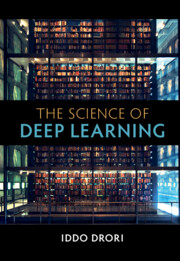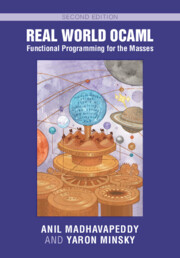Refine search
Actions for selected content:
48290 results in Computer Science
How best to improve upon return-to-player information in gambling? A comparison of two approaches in an Australian sample
-
- Journal:
- Experimental Results / Volume 3 / 2022
- Published online by Cambridge University Press:
- 27 September 2022, e20
-
- Article
-
- You have access
- Open access
- HTML
- Export citation
A spatiotemporal stochastic climate model for benchmarking causal discovery methods for teleconnections
-
- Journal:
- Environmental Data Science / Volume 1 / 2022
- Published online by Cambridge University Press:
- 27 September 2022, e12
-
- Article
-
- You have access
- Open access
- HTML
- Export citation
Potential interactions between metal-based phenanthroline drugs and the unfolded protein response endoplasmic reticulum stress pathway
-
- Journal:
- Experimental Results / Volume 3 / 2022
- Published online by Cambridge University Press:
- 26 September 2022, e22
-
- Article
-
- You have access
- Open access
- HTML
- Export citation

The Science of Deep Learning
-
- Published online:
- 23 September 2022
- Print publication:
- 18 August 2022
-
- Textbook
- Export citation
NWS volume 10 issue 3 Cover and Front matter
-
- Journal:
- Network Science / Volume 10 / Issue 3 / September 2022
- Published online by Cambridge University Press:
- 23 September 2022, pp. f1-f3
-
- Article
-
- You have access
- Export citation
Irregular subgraphs
- Part of
-
- Journal:
- Combinatorics, Probability and Computing / Volume 32 / Issue 2 / March 2023
- Published online by Cambridge University Press:
- 23 September 2022, pp. 269-283
-
- Article
- Export citation
Extreme Behaviors of the Tail Gini-Type Variability Measures
-
- Journal:
- Probability in the Engineering and Informational Sciences / Volume 37 / Issue 4 / October 2023
- Published online by Cambridge University Press:
- 23 September 2022, pp. 928-942
-
- Article
- Export citation
A randomized prospective study of a hybrid rule- and data-driven virtual patient
-
- Journal:
- Natural Language Engineering / Volume 30 / Issue 1 / January 2024
- Published online by Cambridge University Press:
- 23 September 2022, pp. 31-72
-
- Article
-
- You have access
- Open access
- HTML
- Export citation
Preservation properties of some reliability classes by lifetimes of coherent and mixed systems and their signatures
-
- Journal:
- Probability in the Engineering and Informational Sciences / Volume 37 / Issue 4 / October 2023
- Published online by Cambridge University Press:
- 23 September 2022, pp. 943-960
-
- Article
- Export citation

Real World OCaml: Functional Programming for the Masses
-
- Published online:
- 22 September 2022
- Print publication:
- 13 October 2022
-
- Book
-
- You have access
- Open access
- Export citation
Introduction to the Collection of Papers Celebrating the 20th Anniversary of TPLP
-
- Journal:
- Theory and Practice of Logic Programming / Volume 22 / Issue 6 / November 2022
- Published online by Cambridge University Press:
- 22 September 2022, pp. 770-775
-
- Article
-
- You have access
- HTML
- Export citation
A scalable species-based genetic algorithm for reinforcement learning problems
-
- Journal:
- The Knowledge Engineering Review / Volume 37 / 2022
- Published online by Cambridge University Press:
- 19 September 2022, e9
-
- Article
-
- You have access
- Open access
- HTML
- Export citation
Indexed and fibered structures for partial and total correctness assertions
-
- Journal:
- Mathematical Structures in Computer Science / Volume 32 / Issue 9 / October 2022
- Published online by Cambridge University Press:
- 19 September 2022, pp. 1145-1175
-
- Article
-
- You have access
- Open access
- HTML
- Export citation
Distribution-based packet forwarding distance dissimilarity learning for topology characterizing in geographic routing
-
- Journal:
- Experimental Results / Volume 3 / 2022
- Published online by Cambridge University Press:
- 19 September 2022, e19
-
- Article
-
- You have access
- Open access
- HTML
- Export citation
On Establishing Robust Consistency in Answer Set Programs
-
- Journal:
- Theory and Practice of Logic Programming / Volume 23 / Issue 5 / September 2023
- Published online by Cambridge University Press:
- 19 September 2022, pp. 1094-1127
-
- Article
-
- You have access
- Open access
- HTML
- Export citation
Negative attitudes toward older adults: Subjective time to become older and “stereotype embodiment theory”-based intervention
-
- Journal:
- Experimental Results / Volume 3 / 2022
- Published online by Cambridge University Press:
- 19 September 2022, e21
-
- Article
-
- You have access
- Open access
- HTML
- Export citation
All that glitters is not gold: Relational events models with spurious events
-
- Journal:
- Network Science / Volume 11 / Issue 2 / June 2023
- Published online by Cambridge University Press:
- 16 September 2022, pp. 184-204
-
- Article
-
- You have access
- Open access
- HTML
- Export citation


































